Mechanical Recycling of Ethylene-Vinyl Acetate/Carbon Nanotube Nanocomposites: Processing, Thermal, Rheological, Mechanical and Electrical Behavior
Abstract
1. Introduction
2. Research Methodology
3. Materials and Methods
3.1. Virgin Materials
3.2. Mechanical Recycling of EVA/MWCNT Nanocomposites
3.3. Characterization of the EVA/MWCNT Nanocomposites
3.3.1. Differential Scanning Calorimetry
3.3.2. Rheological Analysis
3.3.3. Morphological Analysis
3.3.4. Tensile Testing
3.3.5. Electrical Measurements
3.3.6. Statistical Analysis
4. Results and Discussion
4.1. Thermal Behavior
4.2. Melt Flow Index
4.3. Rheological Behavior
4.4. Activation Energy
4.5. Morphological Analysis
4.6. Mechanical Properties
4.7. Electrical Conductivity
5. Conclusions
Supplementary Materials
Author Contributions
Funding
Institutional Review Board Statement
Informed Consent Statement
Data Availability Statement
Acknowledgments
Conflicts of Interest
References
- Plastics—The Facts 2022. Available online: https://plasticseurope.org/knowledge-hub/plastics-the-facts-2022/ (accessed on 14 December 2022).
- Hood, M. Global Plastic Use and Waste on Track to Triple by 2060. Available online: https://phys.org/news/2022-06-global-plastic-track-triple.html (accessed on 14 December 2022).
- Global Plastic Waste Set to Almost Triple by 2060, Says OECD. Available online: https://www.oecd.org/environment/global-plastic-waste-set-to-almost-triple-by-2060.htm (accessed on 14 December 2022).
- EU Touts 70% Recycling and Zero Landfill Law for 2030. Available online: https://www.euractiv.com/section/sustainable-dev/news/eu-touts-70-recycling-and-zero-landfill-law-for-2030/ (accessed on 17 November 2022).
- Plastics—The Facts 2021, An Analysis of European Plastics Production, Demand and Waste Data. Available online: https://plasticseurope.org/knowledge-hub/plastics-the-facts-2021/ (accessed on 17 November 2022).
- How Hard-to-Recycle Plastic Is Being Made as Good as New. Available online: https://ec.europa.eu/research-and-innovation/en/horizon-magazine/how-hard-recycle-plastic-being-made-good-new (accessed on 21 October 2022).
- Papageorgiou, D.G.; Li, Z.; Liu, M.; Kinloch, I.A.; Young, R.J. Review on Mechanisms of mechanical reinforcement by graphene and carbon nanotubes in polymer nanocomposites. Nanoscale 2020, 12, 2228–2267. [Google Scholar] [CrossRef]
- Kanoun, O.; Bouhamed, A.; Ramalingame, R.; Bautista-Quijano, J.R.; Rajendran, D.; Al-Hamry, A. Review on Conductive Polymer/CNTs Nanocomposites Based Flexible and Stretchable Strain and Pressure Sensors. Sensors 2021, 21, 341. [Google Scholar] [CrossRef]
- Stanciu, N.V.; Stan, F.; Sandu, I.L.; Susac, F.; Fetecau, C.; Rosculet, R.T. Mechanical, electrical and rheological behavior of ethylene-vinyl acetate/multi-walled carbon nanotube composites. Polym. J. 2019, 11, 1300. [Google Scholar] [CrossRef]
- Jia, X.; Wei, F. Advances in production and applications of carbon nanotubes. Top. Curr. Chem. Z. 2017, 375, 299–333. [Google Scholar] [CrossRef]
- Stan, F.; Sandu, I.L.; Fetecau, C. Effect of processing parameters and strain rate on mechanical properties of carbon nanotube-filled polypropylene nanocomposites. Compos. Part. B Eng. 2014, 59, 109–122. [Google Scholar] [CrossRef]
- Zare, Y.; Rhee, K.Y. The effective conductivity of polymer carbon nanotubes (CNT) nanocomposites. J. Phys. Chem. Solids. 2019, 131, 15–21. [Google Scholar] [CrossRef]
- Stan, F.; Stanciu, N.V.; Fetecau, C. Melt rheological properties of ethylene-vinyl acetate/multi-walled carbon nanotube composites. Compos. Part. B Eng. 2017, 110, 20–31. [Google Scholar] [CrossRef]
- Stan, F.; Rosculet, R.T.; Fetecau, C. Direct Current method with reversal polarity for electrical conductivity measurement of TPU/MWCNT composites. Measurement 2019, 136, 345–355. [Google Scholar] [CrossRef]
- Maheswaran, R.; Shanmugavel, B.P. A Critical Review of the Role of Carbon Nanotubes in the Progress of Next-Generation Electronic Applications. J. Electron. Mater. 2022, 51, 2786–2800. [Google Scholar] [CrossRef]
- Carbon Nanotubes Market Size. Available online: https://www.globenewswire.com/news-release/2021/02/16/2176518/0/en/Carbon-Nanotubes-Market-Size-to-Reach-USD-6-03-Billion-by-2027-at-20-CAGR-Market-Research-Future-MRFR.html (accessed on 17 February 2020).
- Janhäll, S.; Petersson, M.; Davidsson, K.; Öman, T.; Sommertune, J.; Kåredal, M.; Messing, M.E.; Rissler, J. Release of carbon nanotubes during combustion of polymer nanocomposites in a pilot-scale facility for waste incineration. NanoImpact 2021, 24, 100357. [Google Scholar] [CrossRef]
- Part, F.; Berge, N.; Baran, P.; Stringfellow, A.; Sun, W.; Bartelt-Hunt, S.; Mitrano, D.; Li, L.; Hennebert, P.; Quicker, P.; et al. A review of the fate of engineered nanomaterials in municipal solid waste streams. Waste Manag. 2018, 75, 427–449. [Google Scholar] [CrossRef] [PubMed]
- Ounoughene, G.; Chivas-Joly, C.; Longuet, C.; Le Bihan, O.; Lopez-Cuesta, J.-M.; Le Coq, L. Evaluation of nanosilica emission in polydimethylsiloxane composite during incineration. J. Hazard. Mater. 2019, 371, 415–422. [Google Scholar] [CrossRef] [PubMed]
- Schyns, Z.O.G.; Shaver, M.P. Review on Mechanical Recycling of Packaging Plastics. Macromol. Rapid Commun. 2021, 42, 2000415. [Google Scholar] [CrossRef]
- Nishida, H. Development of materials and technologies for control of polymer recycling. Polym. J. 2011, 43, 435–447. [Google Scholar] [CrossRef]
- Wu, G.; Li, J.; Xu, Z. Triboelectrostatic separation for granular plastic waste recycling: A review. Waste Manag. 2013, 33, 585–597. [Google Scholar] [CrossRef]
- Marczak, H. Energy Inputs on the Production of Plastic Products. Ecol. Eng. 2022, 23, 146–156. [Google Scholar] [CrossRef]
- Ayre, D. Technology advancing polymers and polymer composites towards sustainability: A review. Curr. Opin. Green Sustain. Chem. 2018, 13, 108–112. [Google Scholar] [CrossRef]
- Zhang, J.; Panwar, A.; Bello, D.; Jozokos, T.; Isaacs, J.A.; Barry, C.; Mead, J. The effects of recycling on the properties of carbon nanotube-filled polypropylene composites and worker exposures. Environ. Sci.-Nano. 2016, 3, 409–417. [Google Scholar] [CrossRef]
- Zhang, J.; Panwar, A.; Bello, D.; Isaacs, J.A.; Jozokos, T.; Mead, J. The effects of recycling on the structure and properties of carbon nanotube-filled polycarbonate. Polym. Eng. Sci. 2018, 58, 1278–1284. [Google Scholar] [CrossRef]
- Chowreddy, R.R.; Nord-Varhaug, K.; Rapp, F. Recycled polyethylene terephthalate/carbon nanotube composites with improved processability and performance. J. Mater. Sci. 2018, 53, 7017–7029. [Google Scholar] [CrossRef]
- Toth, G.; Nagy, D.; Bata, A.; Belina, K. Determination of polymer melts flow-activation energy a function of wide range shear rate. J. Phys. Conf. Ser. 2018, 1045, 012040. [Google Scholar] [CrossRef]
- Pinheiroa, L.A.; Chinelattob, M.A.; Canevarolo, S.V. The role of chain scission and chain branching in high density polyethylene during thermo-mechanical degradation. Polym. Degrad. Stab. 2004, 86, 445–453. [Google Scholar] [CrossRef]
- Svensson, S.; Åkesson, D.; Bohlén, M. Reprocessing of high-density polyethylene reinforced with carbon nanotubes. J. Polym. Environ. 2020, 28, 1967–1973. [Google Scholar] [CrossRef]
- Stan, F.; Sandu, L.I.; Fetecau, C.; Rosculet, R. Effect of reprocessing on the rheological, electrical, and mechanical properties of polypropylene/carbon nanotube composites. J. Micro. Nano. Manuf. 2017, 5, 021005. [Google Scholar] [CrossRef]
- Stan, F.; Stanciu, N.V.; Fetecau, C.; Sandu, I.L. Mechanical recycling of low-density polyethylene/carbon nanotube composites and its effect on material properties. J. Manuf. Sci. Eng. 2019, 141, 091004. [Google Scholar] [CrossRef]
- Chemical Economics Handbook: Ethylene-Vinyl Acetate (EVA); IHS Markit: London, UK, 2022.
- Mark, J.E. Polymer Data Handbook; Oxford University Press: New York, NY, USA, 2009. [Google Scholar]
- Wypych, G. Handbook of Polymers, 2nd ed.; ChemTec Publishing: Toronto, ON, Canada, 2016. [Google Scholar]
- Mostafizur, R. Ethylene Vinyl Acetate/Starch/Clay Biodegradable Nanocomposites; LAP Lambert Academic Publishing: Saarbrucken, Germany, 2017. [Google Scholar]
- The Carbon Nanotube Specialist—Nanocyl. Available online: https://www.nanocyl.com/wp-content/uploads/2016/02/Technical-Data-Sheet-PLASTICYL-EVA2001-V04.pdf/ (accessed on 8 April 2020).
- The Carbon Nanotube Specialist—Nanocyl. Available online: https://www.nanocyl.com/wp-content/uploads/2016/07/DM-TI-02-TDS-NC7000-V08.pdf/ (accessed on 8 April 2020).
- ISO 527-1:2019; Plastics—Determination of Tensile Properties. ISO—International Organization for Standardization: Geneva, Switzerland. Available online: https://www.iso.org/standard/75824.html (accessed on 8 April 2020).
- Martín-Alfonso, J.E.; Franco, J.M. Ethylene-vinyl acetate copolymer (EVA)/sunflower vegetable oil polymer gels: Influence of vinyl acetate content. Polym. Test. 2014, 37, 78–85. [Google Scholar] [CrossRef]
- ISO 1133-1:2011; Plastics—Determination of the Melt Mass-Flow Rate (MFR) and Melt Volume-Flow Rate (MVR) of Thermoplastics. ISO—International Organization for Standardization: Geneva, Switzerland. Available online: https://www.iso.org/standard/44273.html (accessed on 8 April 2020).
- Bryman, A.; Cramer, D. Quantitative Data Analysis with Minitab: A Guide for Social Scientists; Routledge: London, UK, 1996; pp. 155–163. [Google Scholar]
- Ergoz, E.; Fatou, J.G.; Mandelkern, L. Molecular Weight Dependence of the Crystallization Kinetics of Linear Polyethylene. I. Experimental Results. Macromolecules 1972, 5, 147–157. [Google Scholar] [CrossRef]
- Pan, P.; Kai, W.; Zhu, B.; Dong, T.; Inoue, Y. Polymorphous Crystallization and Multiple Melting Behavior of Poly(l-lactide): Molecular Weight Dependence. Macromolecules 2007, 40, 6898–6905. [Google Scholar] [CrossRef]
- Okui, N.; Umemoto, S.; Kawano, R.; Mamun, A. Temperature and Molecular Weight Dependencies of Polymer Crystallization. In Progress in Understanding of Polymer Crystallization; Lecture Notes in Physics; Reiter, G., Strobl, G.R., Eds.; Springer: Berlin/Heidelberg, Germany, 2007; Volume 714, pp. 391–425. [Google Scholar]
- Hornsby, P.R.; Singh, D.P.; Sothern, G.R. Determination of residence time distribution in polymer processing apparatus using tracer techniques. Polym. Test. 1985, 5, 77–97. [Google Scholar] [CrossRef]
- Thurmer, A.; Malik, J.; Dongiovanni, E.; Stoll, H. Stabilization concept of LLDPE with an aspect of improved processing stabilization. In Addcon World ‘98 Additives for the New Millenium, 2nd ed.; Official book of papers; Rapra Technology Ltd.: London, UK, 1998; pp. 10.1–10.5. [Google Scholar]
- Butler, T.I. The influence of extruder residence time distribution on polymer degradation. J. Plast. Film Sheet. 1990, 6, 247–259. [Google Scholar] [CrossRef]
- Mélo, T.J.A.; Pinheiro, L.A.; Canevarolo, S.V. Factorial design to quantify the influence of extrusion parameters in the mean residence time. Polímeros 2009, 20, 322–326. [Google Scholar] [CrossRef]
- Villmow, T.; Kretzschmar, B.; Pötschke, P. Influence of screw configuration, residence time, and specific mechanical energy in twin-screw extrusion of polycaprolactone/multi-walled carbon nanotube composites. Compos. Sci. Technol. 2010, 70, 2045–2055. [Google Scholar] [CrossRef]
- Tobita, H. Model-based reactor design in free-radical polymerization with simultaneous long-chain branching and scission. Processes 2015, 3, 731–748. [Google Scholar] [CrossRef]
- Ainsworth, P.; Ibanoglu, S.; Hayes, G.D. Influence of process variables on residence time distribution and flow patterns of tarhana in a twin-screw extruder. J. Food. Eng. 1997, 32, 101–108. [Google Scholar] [CrossRef]
- Oblak, P.; Gonzalez-Gutierrez, J.; Zupancic, B.; Aulova, A.; Emri, I. Processability and mechanical properties of extensively recycled high density polyethylene. Polym. Degrad. Stabil. 2015, 114, 133–145. [Google Scholar] [CrossRef]
- Sepe, M. Melt Flow Rate Testing-Part 6. Plastics Tehnology. Available online: https://www.ptonline.com/ (accessed on 3 August 2020).
- Kingston, C.; Zepp, R.; Andrady, A.; Boverhof, D.; Fehir, R.; Hawkins, D.; Roberts, J.; Sayre, P.; Shelton, B.; Sultan, Y.; et al. Review on Release characteristics of selected carbon nanotube polymer composites. Carbon 2014, 68, 33–57. [Google Scholar] [CrossRef]
- Yang, M.; Koutsos, V.; Zaiser, M. Interactions between polymers and carbon nanotubes: A molecular dynamics study. J. Phys. Chem. B 2005, 109, 10009–10014. [Google Scholar] [CrossRef] [PubMed]
- Szleifera, I.; Yerushalmi-Rozen, R. Polymers and carbon nanotubes-dimensionality, interactions and nanotechnology. Polym. J. 2005, 46, 7803–7818. [Google Scholar] [CrossRef]
- Abbasi, S.; Carreau, P.J.; Derdouri, A.; Moan, M. Rheological properties and percolation in suspensions of multiwalled carbon nanotubes in polycarbonate. Rheol. Acta 2009, 48, 943–959. [Google Scholar] [CrossRef]
- Rahmat, M.; Hubert, P. Review on Carbon nanotube-polymer interactions in nanocomposites. Compos. Sci. Technol. 2011, 72, 72–84. [Google Scholar] [CrossRef]
- Zaminpayma, E.; Mirabbaszade, K. Interaction between single-walled carbon nanotubes and polymers: A molecular dynamics simulation study with reactive force field. Comput. Mater. Sci. 2012, 58, 7–11. [Google Scholar] [CrossRef]
- Alig, I.; Pötschke, P.; Lellinger, D.; Skipa, T.; Pegel, S.; Kasaliwal, G.R.; Willmow, T. Establishment, morphology and properties of carbon nanotube networks in polymer melts. Polym. J. 2012, 53, 4–28. [Google Scholar] [CrossRef]
- Alig, I.; Lellinger, D.; Engel, M.; Skipa, T.; Pötschke, P. Destruction and formation of a conductive carbon nanotube network in polymer melts: In-line experiments. Polym. J. 2008, 49, 1902–1909. [Google Scholar] [CrossRef]
- Plastic Materials|Free online Database for Plastic Industry. Available online: https://omnexus.specialchem.com/product/t-repsol-alcudia-pa-420 (accessed on 8 April 2020).
- Cabello-Alvarado, C.; Reyes-Rodríguez, P.; Andrade-Guel, M.; Cadenas-Pliego, G.; Pérez-Alvarez, M.; Cruz-Delgado, V.J.; Melo-López, L.; Quiñones-Jurado, Z.V.; Ávila-Orta, C.A. Melt-Mixed Thermoplastic Nanocomposite Containing Carbon Nanotubes and Titanium Dioxide for Flame Retardancy Applications. Polym. J. 2019, 11, 1204. [Google Scholar] [CrossRef] [PubMed]
- Yang, R. Chapter 7—Polymer degradation and stability. In Polymer Science and Nanotechnology. Fundamentals and Applications; Elsevier: Amsterdam, The Netherlands, 2020; pp. 125–148. [Google Scholar]
- Shenoy, A.V.; Saini, D.R. Upgrading the melt flow index to rheogram approach in the low shear rate region. J. Appl. Polym. Sci. 1984, 29, 1581–1593. [Google Scholar] [CrossRef]
- Bremner, T.; Rudin, A.; Cook, D.G. Melt flow index values and molecular weight distributions of commercial thermoplastics. J. Appl. Polym. Sci. 1990, 41, 1617–1627. [Google Scholar] [CrossRef]
- Shendge, V.; Borade, D.; Padkodne, M.; Narkhede, S. A Low Cost Automation for MFI Analyzer by Using Arduino. In Proceedings of the 2nd International Conference on Communication & Information Processing (ICCIP), Pune, India, 5 April 2020. [Google Scholar] [CrossRef]
- Cruz Sanchez, F.A.; Lanza, S.K.; Boudaoud, H.; Hoppe, S.; Camargo, M. Polymer recycling and additive manufacturing in an open source context: Optimization of processes and methods. In Proceedings of the Conference: 2015 Annual International Solid Freeform Fabrication Symposium—An Additive Manufacturing Conference, Austin, TX, USA, 10–12 August 2015; Bourell, D.L., Ed.; University of Texas at Austin: Austin, TX, USA, 2015. [Google Scholar]
- Lopez, J.P.; Girones, J.; Mendez, J.A.; Puig, J.; Pelach, M.A. Recycling ability of biodegradable matrices and their cellulose-reinforced composites in a plastic recycling stream. J. Polym. Environ. 2012, 20, 96–103. [Google Scholar] [CrossRef]
- Cruz, S.A.; Zanin, M. Evaluation and identification of degradative processes in post-consumer recycled high-density polyethylene. Polym. Degrad. Stab. 2003, 80, 31–37. [Google Scholar] [CrossRef]
- Morrison, F.A. Understanding Rheology; Oxford University Press: London, UK, 2000. [Google Scholar]
- Liang, J.Z.; Chen, C.Y.; Zou, S.Y.; Tsui, C.P.; Tang, C.Y.; Zhang, S.D. Melt flow behavior of polypropylene composites filled with multi-walled carbon nanotubes during extrusion. Polym. Test. 2015, 45, 41–46. [Google Scholar] [CrossRef]
- Vyazovkin, S. Activation Energies and Temperature Dependencies of the Rates of Crystallization and Melting of Polymers. Polym. J. 2020, 12, 1070. [Google Scholar] [CrossRef]
- Ball, D.W.; Key, J.A. Introductory Chemistry, 1st Canadian ed.; BCCAMPUS: Victoria, BC, Canada, 2014; pp. 915–918. [Google Scholar]
- Lima, P.; Magalhaes da Silva, S.P.; Oliveira, J.; Costa, V. Rheological properties of ground tyre rubber based thermoplastic elastomeric blends. Polym. Test. 2015, 45, 58–67. [Google Scholar] [CrossRef]
- Boronat, T.; Segui, V.J.; Peydro, M.A.; Reig, M.J. Influence of temperature and shear rate on the rheology and processability of reprocessed ABS in injection molding process. J. Mater. Process. Technol. 2009, 209, 2735–2745. [Google Scholar] [CrossRef]
- Tamayo-Vegas, S.; Muhsan, A.; Liu, C.; Tarfaoui, M.; Lafdi, K. The Effect of Agglomeration on the Electrical and Mechanical Properties of Polymer Matrix Nanocomposites Reinforced with Carbon Nanotubes. Polym. J. 2022, 14, 1842. [Google Scholar] [CrossRef]
- Stan, F.; Sandu, I.L.; Turcanu, A.M.; Stanciu, N.V.; Fetecau, C. The Influence of Carbon Nanotubes and Reprocessing on the Morphology and Properties of High-Density Polyethylene/Carbon Nanotube Composites. J. Manuf. Sci. Eng. Trans. ASME 2022, 144, 41011. [Google Scholar] [CrossRef]
- Jia, L.C.; Yan, D.X.; Cui, C.H.; Jiang, X.; Ji, X.; Li, Z.M. Electrically conductive and electromagnetic interference shielding of polyethylene composites with devisable carbon nanotube networks. J. Mater. Chem. C 2015, 3, 9369–9378. [Google Scholar] [CrossRef]
- Stanciu, N.V.; Stan, F.; Sandu, I.L.; Fetecau, C.; Turcanu, A.M. Thermal, Rheological, Mechanical, and Electrical Properties of Polypropylene/Multi-Walled Carbon Nanotube Nanocomposites. Polym. J. 2021, 13, 187. [Google Scholar] [CrossRef]
- Castellino, M.; Rovere, M.; Shahzad, M.I.; Tagliaferro, A. Conductivity in carbon nanotube polymer composites: A comparison between model and experiment. Compos. A Appl. Sci. 2016, 87, 237–242. [Google Scholar] [CrossRef]
- Tao, X.; Liao, S.; Wang, Y. Polymer-assisted fully recyclable flexible sensors. EcoMat 2021, 3, e12083. [Google Scholar] [CrossRef]
- Stauffer, D.; Aharony, A. Introduction to Percolation Theory, 2nd ed.; Taylor & Francis: London, UK, 1992. [Google Scholar]
- Bauhofer, W.; Kovacs, J.Z. A review and analysis of electrical percolation in carbon nanotube polymer composites. Comp. Sci. Technol. 2009, 69, 1486–1498. [Google Scholar] [CrossRef]
- Han, Z.; Fina, A. Thermal conductivity of carbon nanotubes and their polymer nanocomposites: A review. Prog. Polym. Sci. 2011, 36, 914–944. [Google Scholar] [CrossRef]
- Wang, J.; Kasemi, Y.; Wang, S.; Hamidinejad, M.; Mahmud, M.B.; Potschke, P.; Park, C.B. Enhancing the electrical conductivity of PP/CNT nanocomposites through crystal-induced volume exclusion effect with a slow cooling rate. Compos. B 2020, 183, 107663. [Google Scholar] [CrossRef]
- Zare, Y.; Rhee, K.Y. Modeling the effect of interfacial conductivity between polymer matrix and carbon nanotubes on the electrical conductivity of nanocomposites. RSC Adv. 2020, 10, 424–433. [Google Scholar] [CrossRef] [PubMed]
- Min, C.; Shen, X.; Shi, Z.; Chen, L.; Xu, Z. The Electrical Properties and Conducting Mechanisms of Carbon Nanotube/Polymer Nanocomposites: A Review. Polym Plast Technol Eng. 2010, 49, 1172–1181. [Google Scholar] [CrossRef]
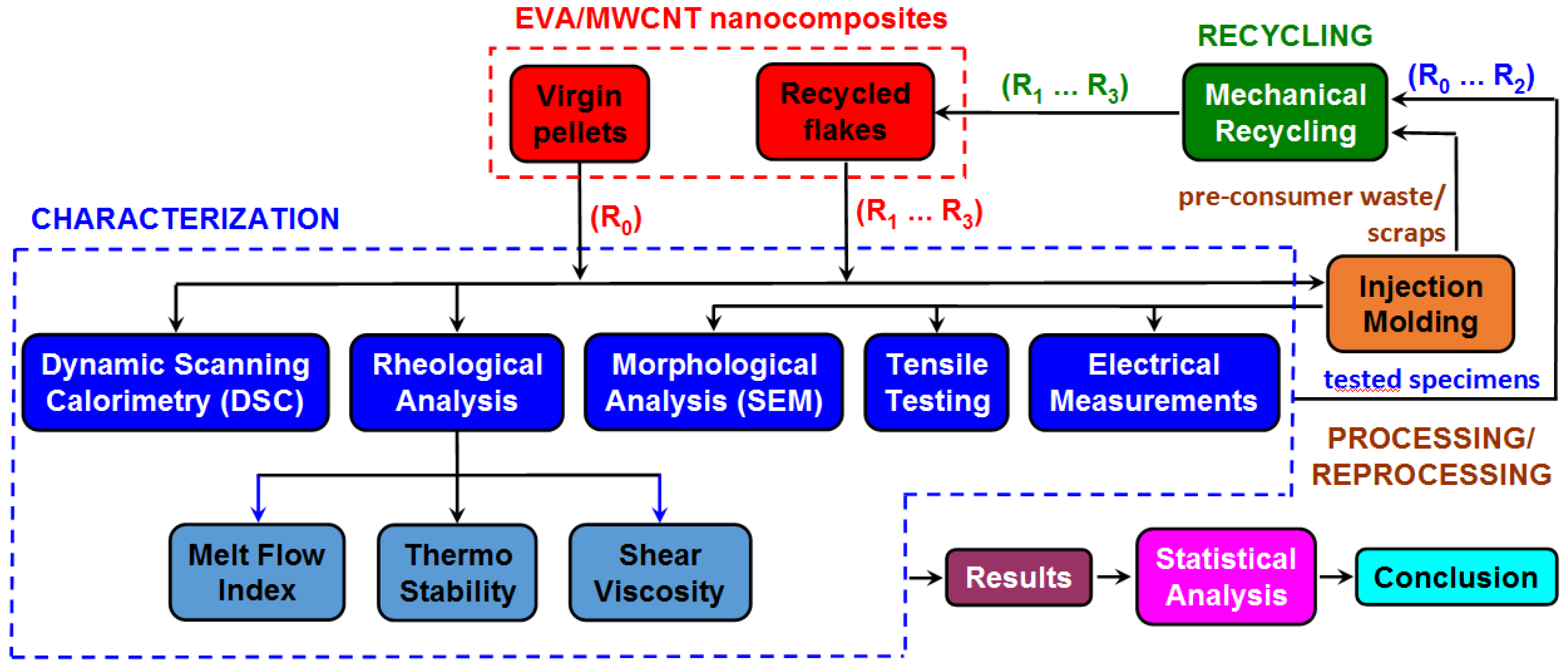
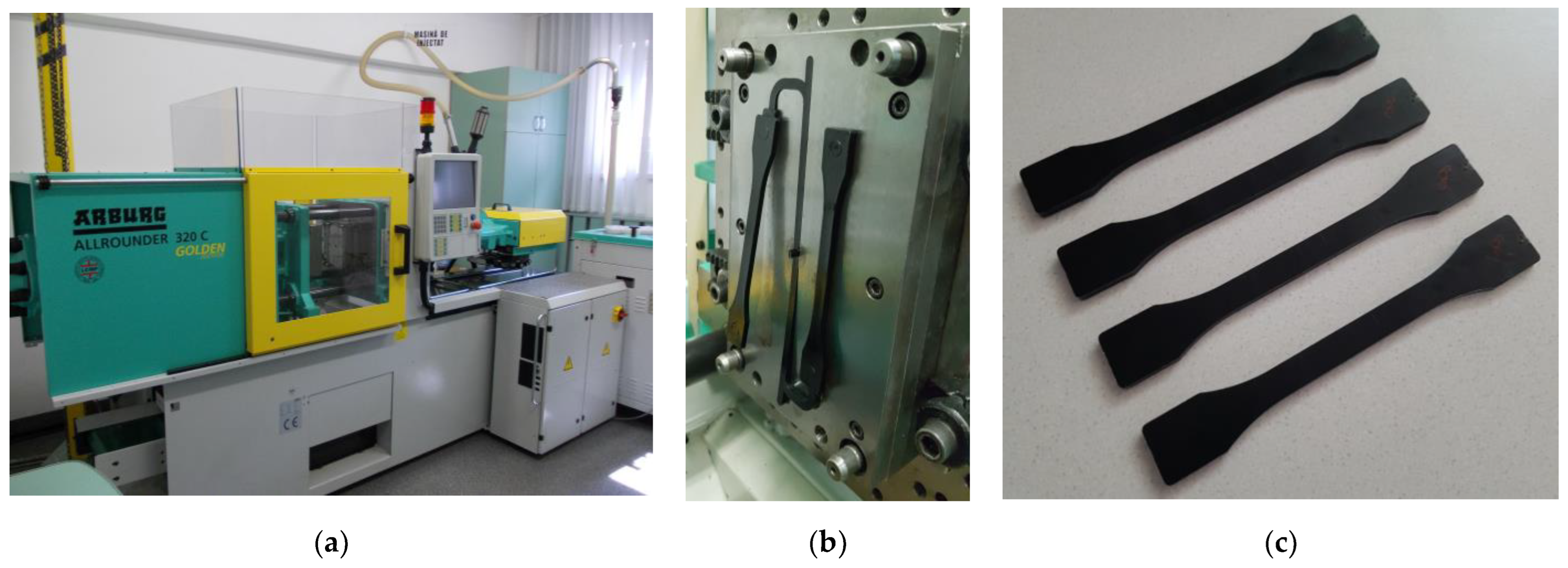
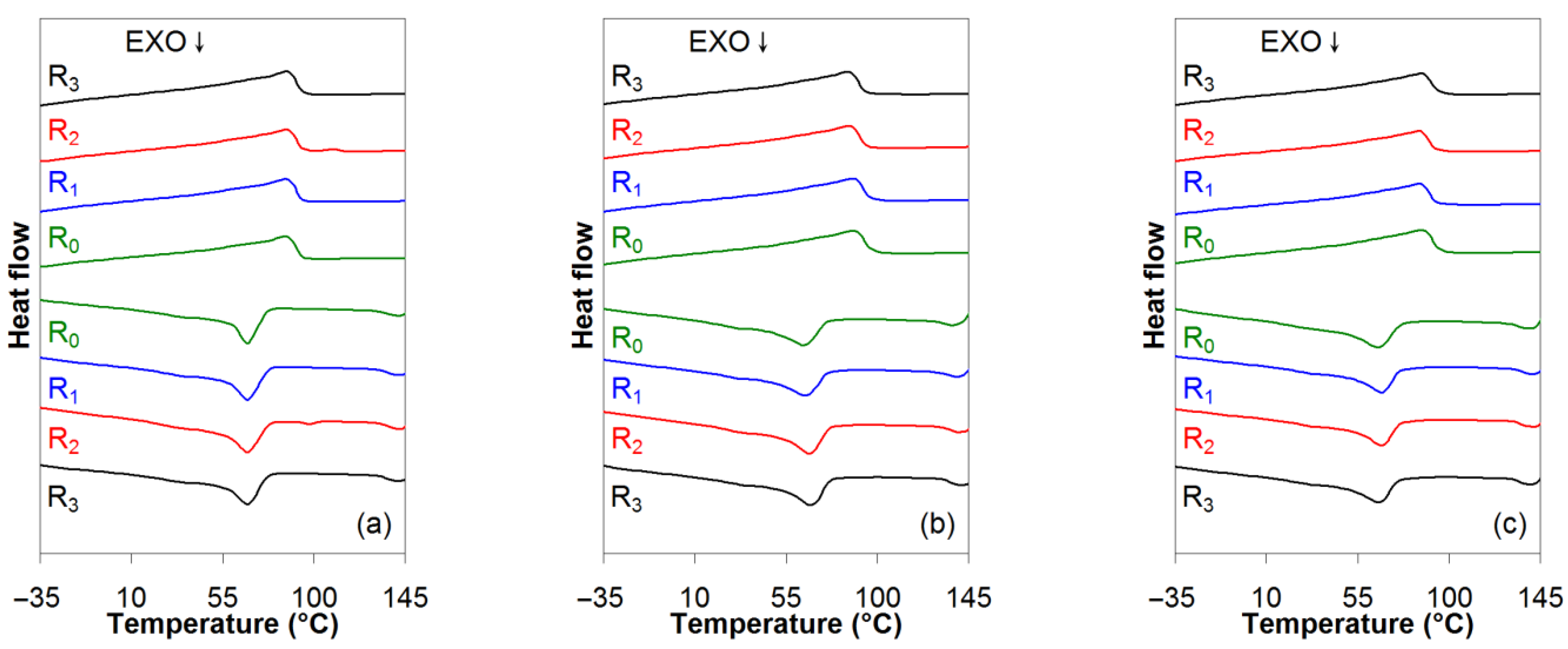



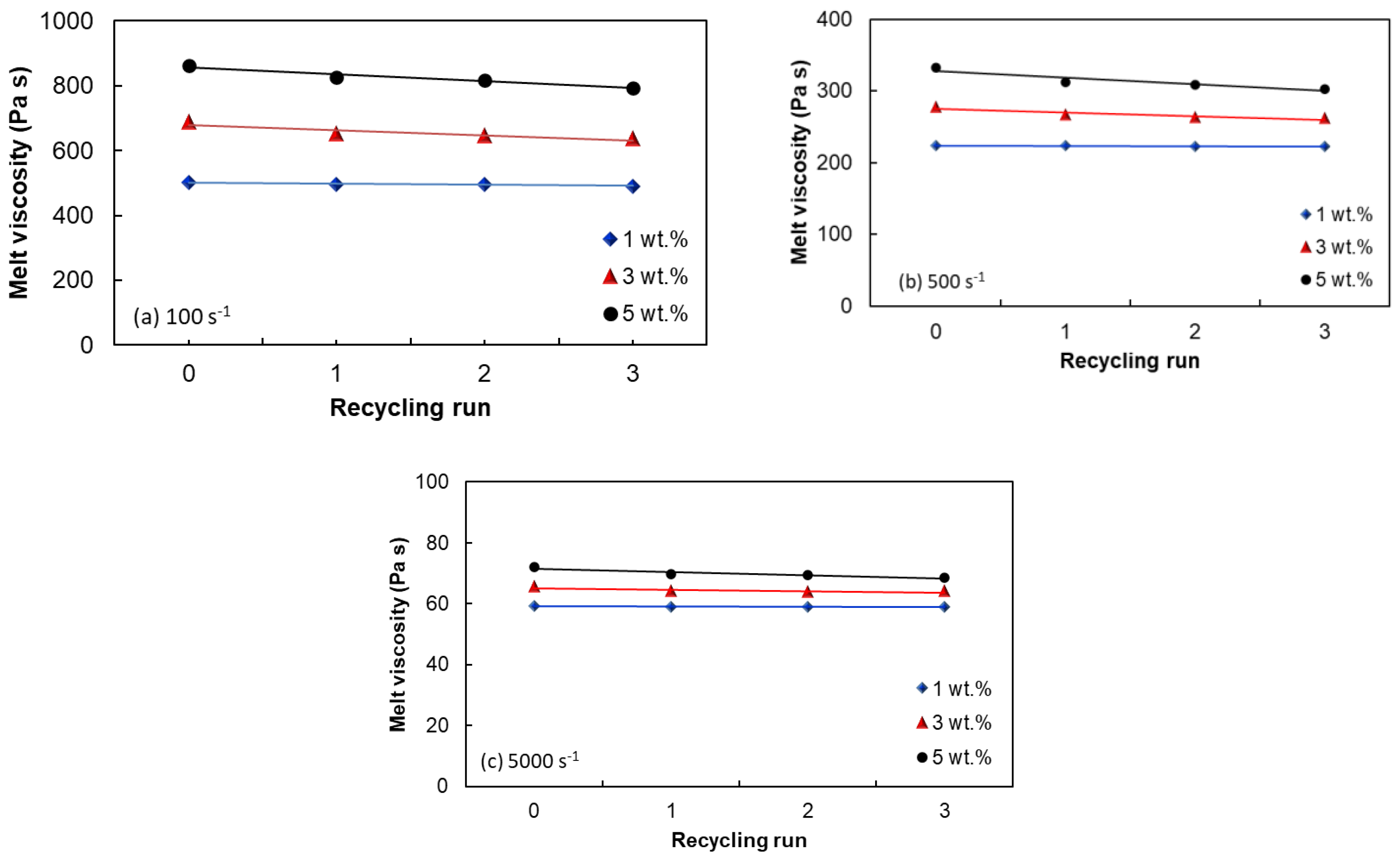




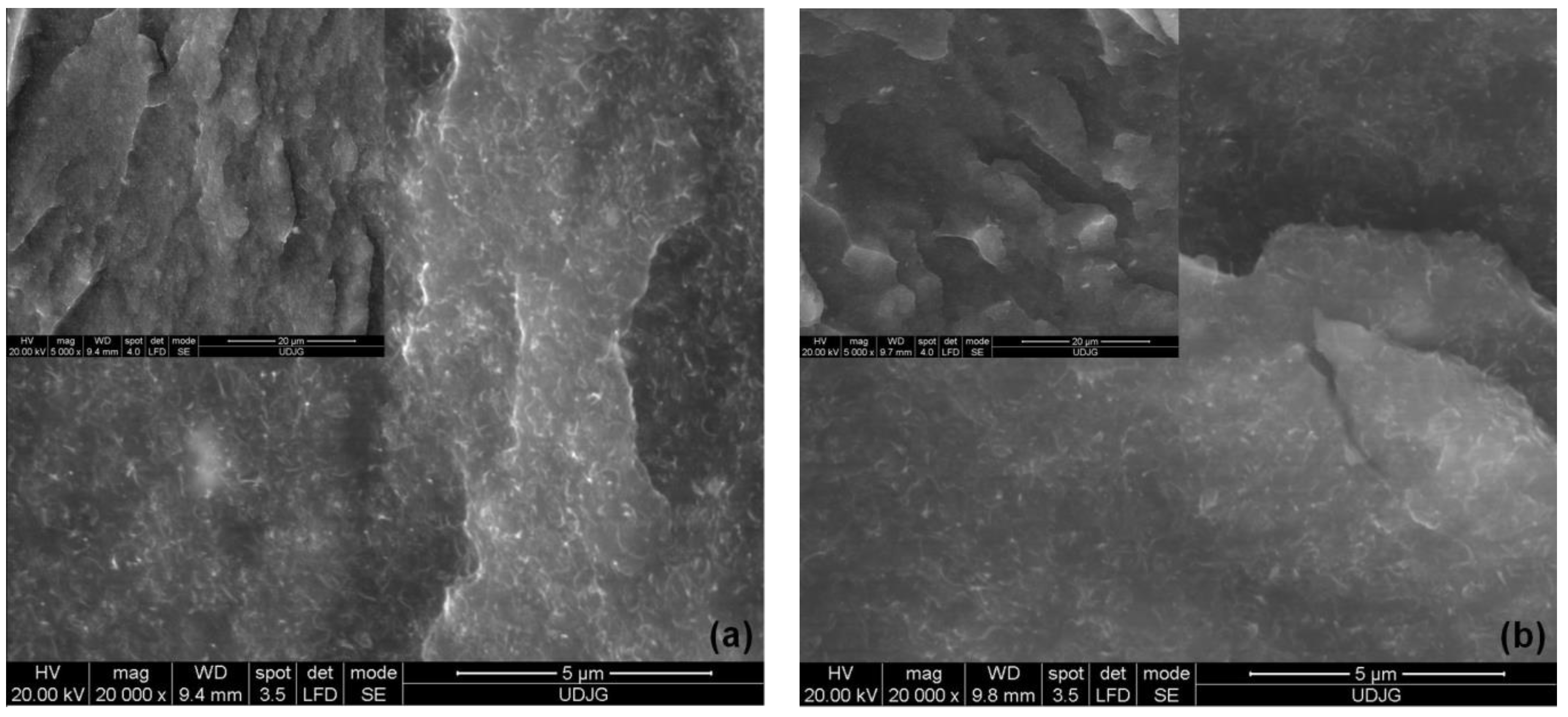
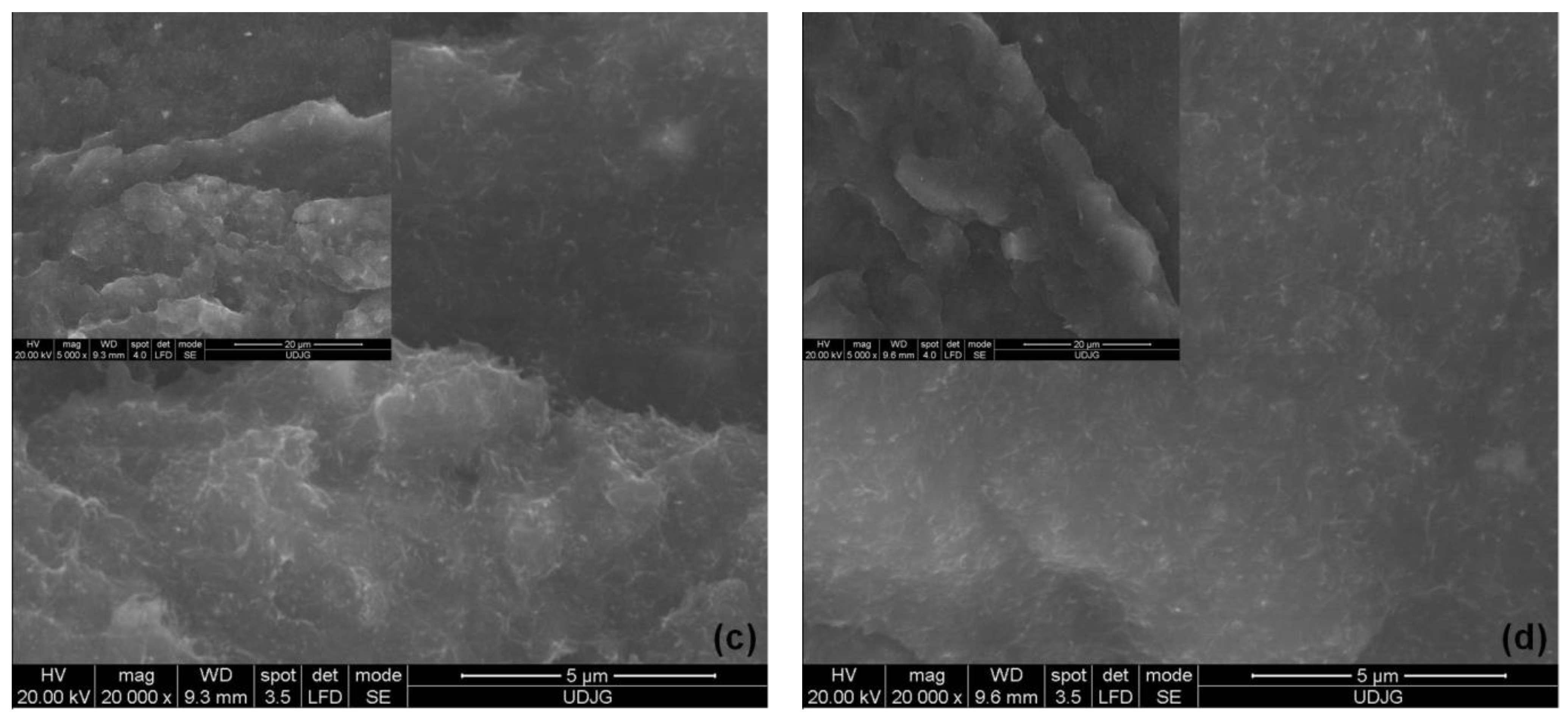
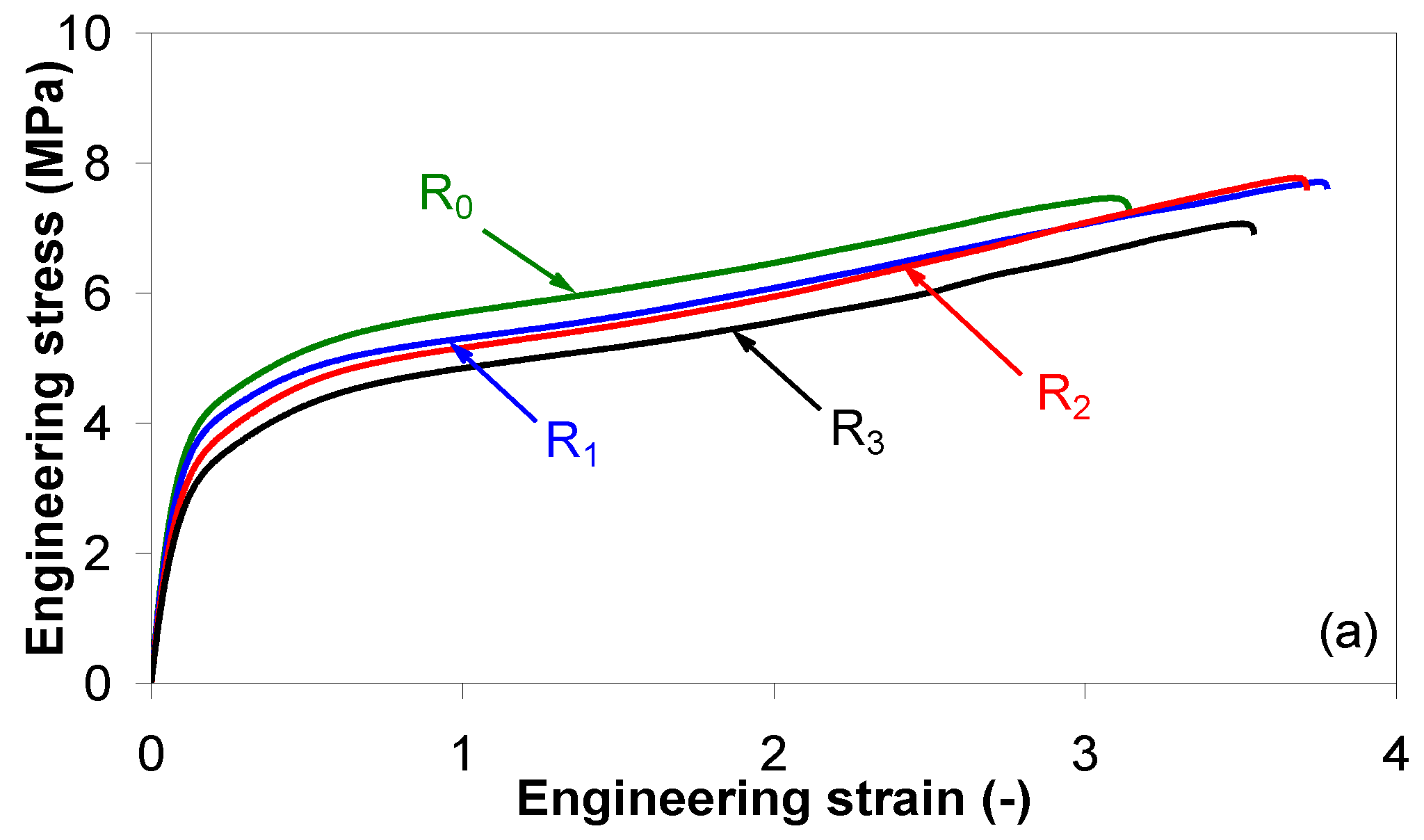
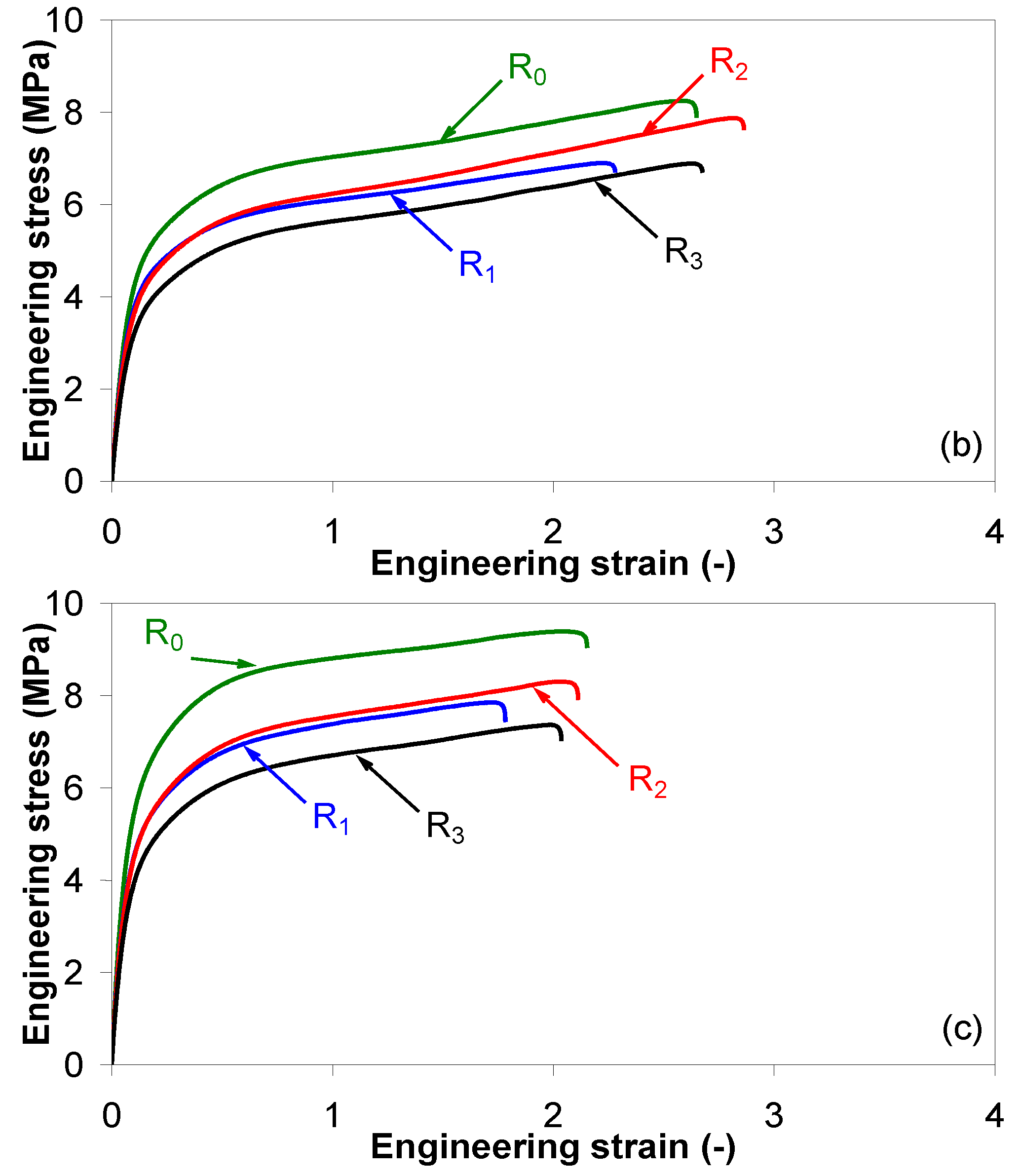
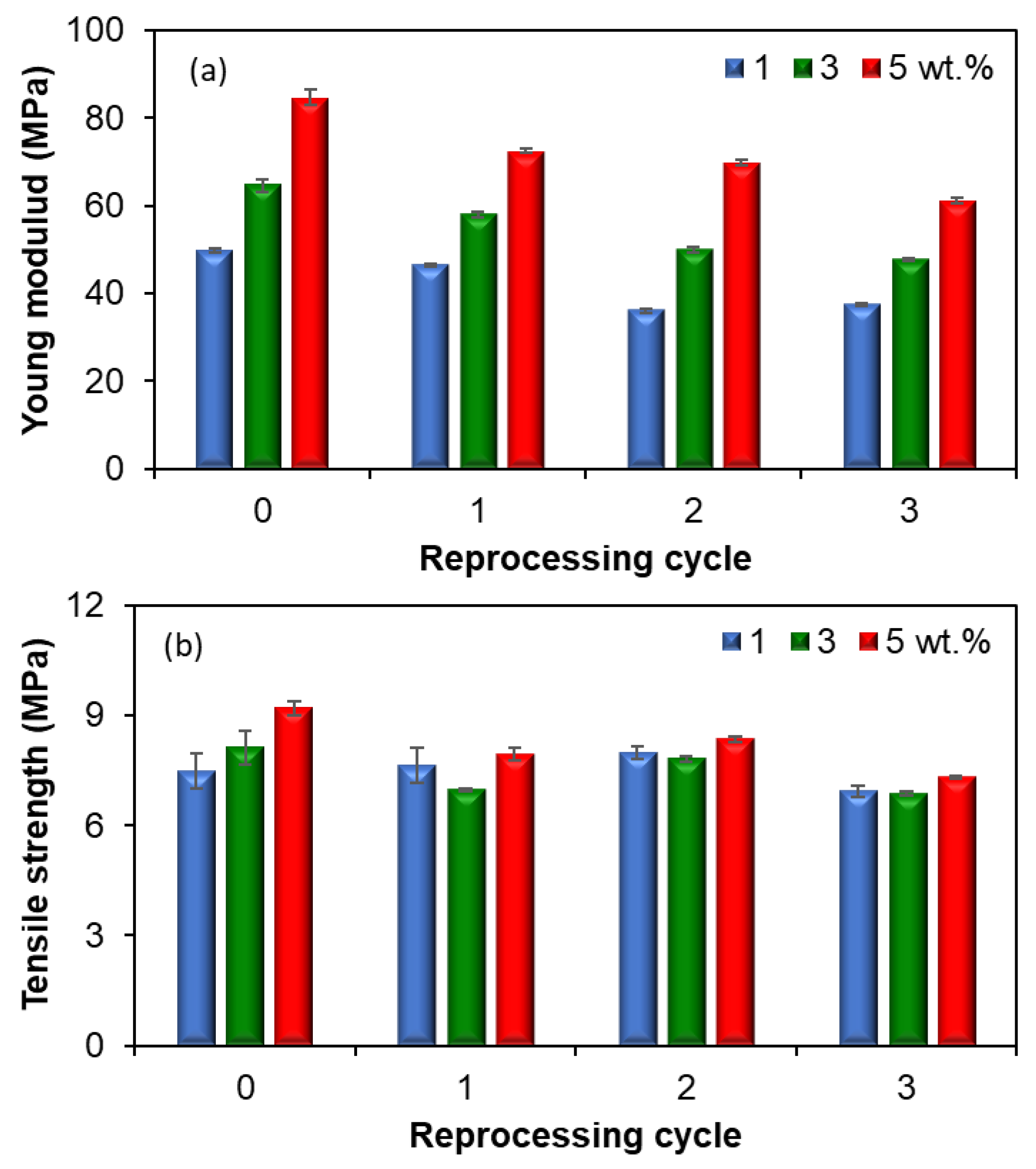



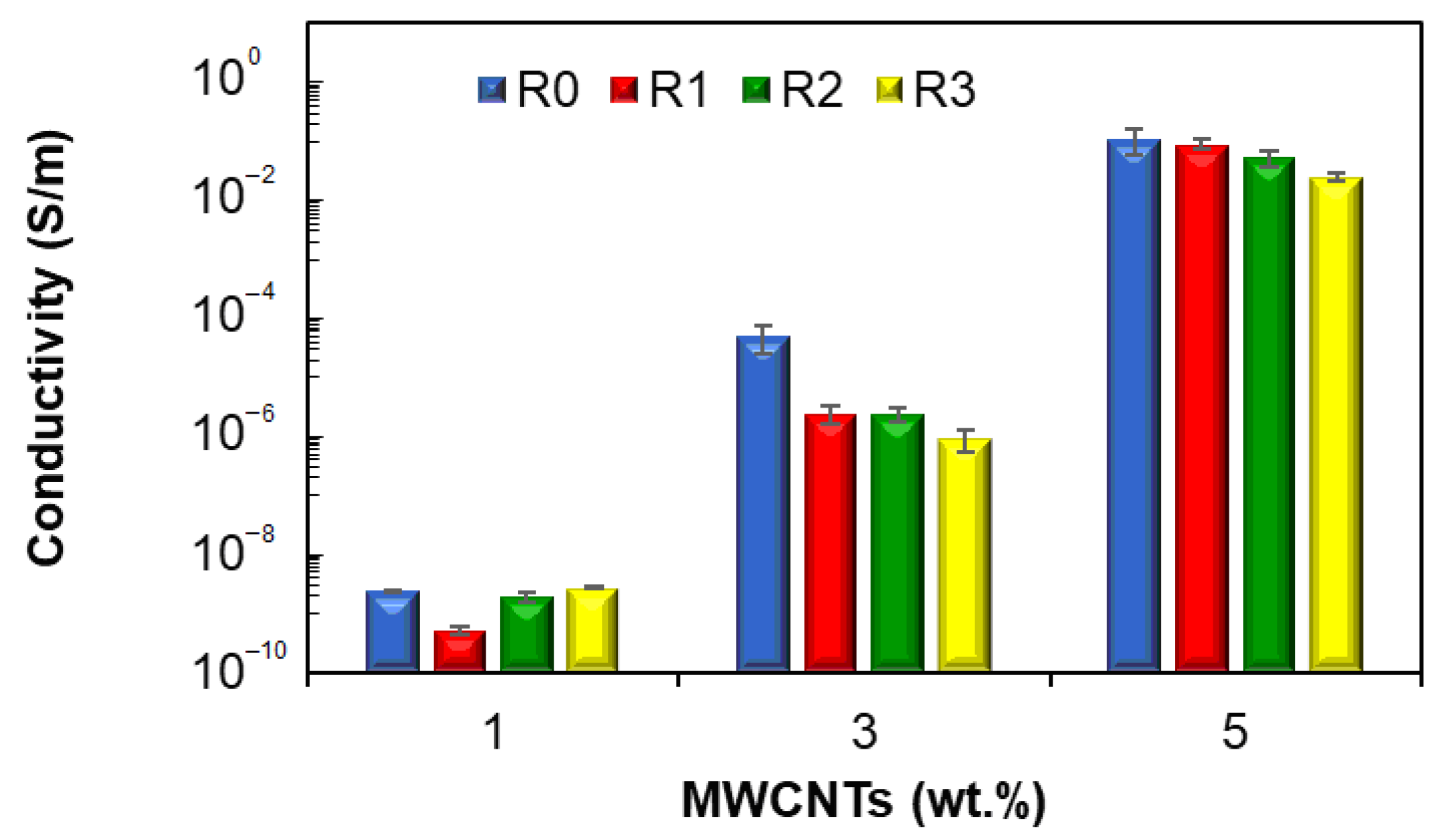
| MWCNTs (wt.%) | Recycling Cycle | Cooling | Second Heating | Tm–Tc (°C) | ||||
|---|---|---|---|---|---|---|---|---|
| Tc (°C) | ΔHc (J/g) | Tg (°C) | Tm (°C) | ΔHm (J/g) | ||||
| 1 | R0 | 67 | 70.72 | −25 | 86 | 70.13 | 24.74 | 19 |
| R1 | 67 | 68.39 | −24 | 86 | 65.01 | 22.94 | 19 | |
| R2 | 67 | 63.18 | −28 | 86 | 57.57 | 20.31 | 20 | |
| R3 | 67 | 60.74 | −27 | 86 | 62.83 | 22.17 | 20 | |
| 3 | R0 | 64 | 71.85 | −24 | 88 | 76.51 | 27.55 | 24 |
| R1 | 64 | 64.16 | −27 | 88 | 64.24 | 23.13 | 24 | |
| R2 | 66 | 64.41 | −27 | 86 | 61.81 | 22.26 | 19 | |
| R3 | 67 | 59.77 | −30 | 86 | 59.97 | 21.59 | 19 | |
| 5 | R0 | 65 | 58.82 | −29 | 87 | 65.47 | 24.07 | 22 |
| R1 | 66 | 59.59 | −31 | 85 | 58.32 | 21.44 | 18 | |
| R2 | 67 | 57.07 | −28 | 85 | 56.91 | 20.92 | 18 | |
| R3 | 65 | 54.34 | −27 | 87 | 60.27 | 22.16 | 20 | |
| Temperature, (°C) | MWCNTs, (wt.%) | Consistency Index, K (Pa·sn) | Shear-Thinning Index, n (−) | ||||||
|---|---|---|---|---|---|---|---|---|---|
| Reprocessing Cycle, (−) | |||||||||
| R0 | R1 | R2 | R3 | R0 | R1 | R2 | R3 | ||
| 140 | 1 | 10,573 | 10,098 | 10,176 | 10,288 | 0.42 | 0.42 | 0.42 | 0.42 |
| 3 | 17,121 | 16,461 | 15,496 | 15,122 | 0.37 | 0.37 | 0.38 | 0.38 | |
| 5 | 24,456 | 22,818 | 22,780 | 21,151 | 0.35 | 0.34 | 0.34 | 0.35 | |
| 160 | 1 | 6314 | 6283 | 6310 | 6161 | 0.46 | 0.46 | 0.45 | 0.46 |
| 3 | 11,536 | 10,177 | 9956 | 9719 | 0.40 | 0.41 | 0.41 | 0.41 | |
| 5 | 16,607 | 15,427 | 15,371 | 14,377 | 0.36 | 0.37 | 0.37 | 0.38 | |
| 180 | 1 | 4181 | 4012 | 3969 | 3931 | 0.48 | 0.49 | 0.49 | 0.49 |
| 3 | 7561 | 7496 | 6939 | 6515 | 0.43 | 0.42 | 0.43 | 0.44 | |
| 5 | 11,884 | 11,376 | 10,868 | 10,570 | 0.38 | 0.38 | 0.39 | 0.39 | |
Disclaimer/Publisher’s Note: The statements, opinions and data contained in all publications are solely those of the individual author(s) and contributor(s) and not of MDPI and/or the editor(s). MDPI and/or the editor(s) disclaim responsibility for any injury to people or property resulting from any ideas, methods, instructions or products referred to in the content. |
© 2023 by the authors. Licensee MDPI, Basel, Switzerland. This article is an open access article distributed under the terms and conditions of the Creative Commons Attribution (CC BY) license (https://creativecommons.org/licenses/by/4.0/).
Share and Cite
Sandu, I.-L.; Stan, F.; Fetecau, C. Mechanical Recycling of Ethylene-Vinyl Acetate/Carbon Nanotube Nanocomposites: Processing, Thermal, Rheological, Mechanical and Electrical Behavior. Polymers 2023, 15, 583. https://doi.org/10.3390/polym15030583
Sandu I-L, Stan F, Fetecau C. Mechanical Recycling of Ethylene-Vinyl Acetate/Carbon Nanotube Nanocomposites: Processing, Thermal, Rheological, Mechanical and Electrical Behavior. Polymers. 2023; 15(3):583. https://doi.org/10.3390/polym15030583
Chicago/Turabian StyleSandu, Ionut-Laurentiu, Felicia Stan, and Catalin Fetecau. 2023. "Mechanical Recycling of Ethylene-Vinyl Acetate/Carbon Nanotube Nanocomposites: Processing, Thermal, Rheological, Mechanical and Electrical Behavior" Polymers 15, no. 3: 583. https://doi.org/10.3390/polym15030583
APA StyleSandu, I.-L., Stan, F., & Fetecau, C. (2023). Mechanical Recycling of Ethylene-Vinyl Acetate/Carbon Nanotube Nanocomposites: Processing, Thermal, Rheological, Mechanical and Electrical Behavior. Polymers, 15(3), 583. https://doi.org/10.3390/polym15030583






